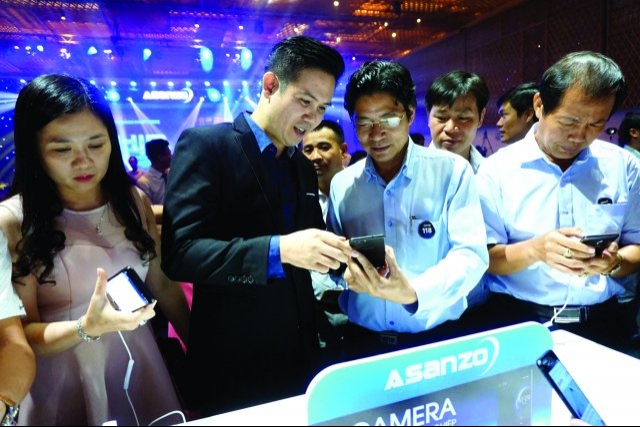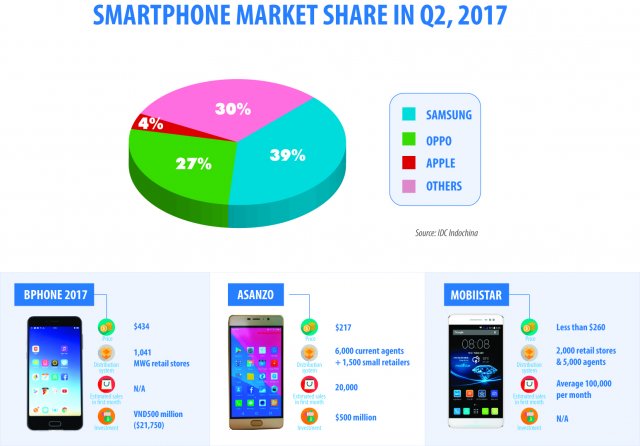Samsung and Apple now battle it out in the high-end segment. In releasing the Bphone 2017, BKAV needs to differentiate the product, not just advertise it, according to ValueInvest’s Chairman Nguyen Thang, in order to compete.
Buyers in the high-end segment will think carefully about the brand and its quality and prestige, and persuading them will take some effort, he added, as its competitors have been in the market for some time.

Different to the Bphone, Asanzo, a TV maker, has positioned its new smartphone in the mid-end segment, which is under $220. After being successful in selling TVs in rural areas, CEO Pham Van Tam is confident it can again prosper in the countryside with its smartphones.
Interestingly, the mid-end segment has been the target of many smartphone manufacturers this year, according to local insiders.
“The average retail price for a smartphone was $205, excluding VAT, in the second quarter in Vietnam,” said Mr. Thanh. “Positioning the price at around that level is a suitable strategy.”
There are always obstacles and challenges in the smartphone market, as Mr. Tam told VET he spent three years and significant resources on building strong production and distribution systems.
But he is confident about its products catching up with global trends, as he has a good staff specializing in software.
“The hardest part of making a mobile phone is the software,” he said. “Software changes every day. I spent a great deal of time and money on training our software staff.”
The key feature for Asanzo is creating a musical experience for consumers. “Other brands focus on the selfie camera, while Asanzo does likewise but has a difference,” Mr. Tam said. “Our products have wireless headphones for those who are young and dynamic.”
Asanzo will target workers and students in rural areas initially, with a price tag of less than $220. “Our products are cheap but of good quality,” Mr. Tam said.
“At this time, we haven’t set profit as a priority. We have cut unnecessary costs to provide real value and to support our customers better.”
Both BKAV and Asanzo acknowledge the market is more intense and requires a substantial amount of money be poured in.
“We’re not thinking about profit at the moment,” Mr. Quang also said. “We are still in the process of conquering consumer confidence.”
Big ambitions

Foreign brands like Samsung (with a 39 per cent market share), OPPO (27 per cent) and Apple (4 per cent), led the smartphone market in the second quarter of 2017, according to IDC Indochina.
The market share of Vietnamese smartphone brands was estimated at 6 per cent, against 19 per cent in the second quarter of last year.
“Vietnamese smartphone brands are fading away in the domestic market,” Mr. Thanh noted.
Despite the disadvantages, Mr. Tam believes the brand will gain a 5 per cent market share within two to three years.
He is confident about the company’s ability to understand users, especially those in rural areas, and that the development of its distribution network, with 6,000 agents, will see 20,000 units sold during the launch.
The company will also cooperate with about 1,600 small mobile phone and electronic product retailers in rural areas by the end of this year. “By distributing products at small retailers, we can ease the pressure of competing with large retailers,” he said.
Also targeting the mid-end segment, Vietnamese brand Mobiistar has retained its place among the Top 5 brands in the country, successfully competing with local brands such as Masstel, FPT, Viettel, VinaPhone, and Bavapen.
“Mobiistar pays attention to its products and what users think about its products,” Mr. Thanh said. “This helps it position itself in the smartphone market.”
Forgoing the grand openings or advertising and marketing campaigns adopted by Samsung, OPPO, Bphone and Asanzo. Mobiistar’s branding strategy is unique.
“What we have done is somewhat modest and not the same as other smaller brands,” Mobiistar’s CEO Ngo Nguyen Kha told VET.
“We focus on products, bringing the best experiences to consumers and taking care of the user community to win their trust. We are building deep relations with those that are interested in Mobiistar.”
The competitive factor Mr. Kha sees as allowing the brand to compete with big foreign brands is its ability to understand users.
“We pursue providing an enjoyable experience,” he said. “Being a Vietnamese brand is not a competitive factor.” The smartphone market is more distinctly differentiated between the leaders and the followers.
“The gap is huge,” he added. “Brands, including Vietnamese brands, must have clear strengths in product and supply chains and an ability to understand the user.”
Conversely, Bphone’s CEO is, perhaps, being too ambitious in targeting the high-end segment. But Mr. Quang believes that once the Bphone 2017 finds success, the brand will also conquer the mid-end segment.
“BKAV will then be one of the leading smartphone brands in the world,” he said.
“We can provide an example in the development of Vietnam’s smartphone manufacturing industry.”
Creating a smartphone manufacturing industry in Vietnam is a long-term effort, as the market is saturated, according to Mr. Thanh. Moreover, smartphone hardware earns less profit than software and solutions.
“Local manufacturers need to understand what their strengths and weaknesses are, in order to define a suitable long-term strategy,” he said.
VN Economic Times